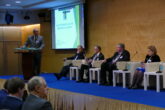ANALYSIS OF METHODS FOR MINIMIZING NETWORK DELAY IN COMMUNICATION CHANNELS DURING THE TRANSMISSION OF INDUSTRIAL INTERNET OF THINGS TRAFFIC
Phuc Hao Do, The Bonch-Bruevich Saint-Petersburg State University of Telecommunications (SPbSUT), Danang Architecture University (DAU), postgraduate; haodp@dau.edu.vn
A.A. Berezkin, SPbSUT, associate professor, Ph.D.; aa. berezkin@mail.ru
D.D. Parfenov, SPbSUT, student; parfenov@ista.ru.
D.S. Kukunin, SPbSUT, associate professor, Ph.D.; coux@yandex.ru
R.V. Kirichek, SPbSUT, chancellor, associate professor, Dr.Sci.(Tech.); kirichek@sut.ru
Today, artificial intelligence (AI) is the leading technology of the 4.0 technology revolution. Furthermore, the Industrial Internet of Things (IIoT) improves industrial processes and applications through intelligent sensors, actuators, fast communication protocols, and effective cybersecurity processes. Reducing latency in communication between devices in the IIoT industry in communication channels is a fundamental challenge. In this paper, we will analyze the resolution reduction methods in communication channels and experimentally will focus on reducing the delay in command transmission from the controller to the robotic arm to perform a predefined task. We propose to use an intelligent model to predict the tasks that the robotic arm needs to perform through input data in the form of time series. Instead of sending all commands, the model predicts the task and passes the task type to the robotic arm. Experiments show that the classification of commands and tasks will help reduce the traffic sent from the controller to the robotic arm, thereby reducing network latency.
Keywords: satellite communication, data transmission, Internet of Things, IoT, Industrial Internet of Things, IIoT, IIoT traffic, predictive models, intelligent models, neural network.
AUTONOMOUS POWER SUPPLIES OF IoT DEVICES FOR DIGITALIZATION OF REMOTE AND SPARSELY POPULATED AREAS
P.I. Antonovich, FSBI NIIR, director of the Internet of Things Research Center (IoTRC), associate professor, Dr.Sci.(Mil.); p. antonovich@niir.ru
A.A. Zaharov, FSBI NIIR, deputy general director for science, associate professor, Ph.D.; a. zaharov@niir.ru
K.N. Leonov, FSBI NIIR, lead engineer of the IoTRC, Ph.D.; leonovkn@niir.ru
N.V. Korolev, FSBI NIIR, lead engineer of the IoTRC, Ph.D.; korolev@niir.ru
A review and analysis of technologies for providing autonomous power supply to the system of Internet of Things devices in remote, hard-to-reach and sparsely populated areas in the interests of eliminating the digital divide has been carried out.
Keywords: Internet of Things, IoT, elimination of the digital divide, autonomous power supply, communication and data transmission systems, remote and sparsely populated areas, digitalization.
ASYNCHRONOUS DATA TRANSFER USING MULTILAYER ORTHOGONAL STRUCTURES IN CDMA SYSTEMS
D.S. Kukunin, The Bonch-Bruevich Saint-Petersburg State University of Telecommunications (SPbSUT), associate professor, Ph.D.; coux@yandex.ru
A.A. Berezkin, SPbSUT, associate professor, Ph.D.; aa. berezkin@mail.ru
R.V. Kirichek, SPbSUT, chancellor, associate professor, Dr.Sci.(Tech.); kirichek@sut.ru
K.A. Eliseeva, SPbSUT, student; drami6869@mail.ru
This work links the technologies of asynchronous data transmission and code division through a new type of orthogonal signals developed on the basis of recurrent maximum length sequences. The multilayer orthogonal structures obtained from them, which have a number of useful properties of classical M-sequences, make it possible to form self-synchronizing data blocks that can be used in the process of direct sequence spread spectrum. This method of spread spectrum allows not only to increase the signal base, but also to organize multiple access with code separation of channels. The methods used for processing the multiplexed signal are based on the mathematical apparatus of linear algebra, which provides, first of all, a high degree of noise immunity of the data transmission system in conditions of an increased level of interference.
Keywords: multiple access, code compression, maximum length sequence, synchronization, Galois field.
METHODOLOGY FOR IMPROVING THE EFFECTIVENESS OF THE FACE IDENTIFICATION ALGORITHM
R.M. Vivchar, The Bonch-Bruevich Saint-Petersburg State University of Telecommunications (SPbSUT), department of software engineering and computer science (SE&CS), associate professor, Ph.D.; ramzec9322@rambler.ru
A.V. Pachin, SPbSUT, department of SE&CS, associate professor, Ph.D.; pachin. andrej@bk.ru
I.O. Titarenko, SPbSUT, student; titarenkoio233@gmail.com
R.V. Kirichek, SPbSUT, chancellor, associate professor, Dr.Sci.(Tech.); kirichek@sut.ru
The article discusses a technique designed to improve the effectiveness of algorithms for face identification in various biometric systems. The main indicators of the effectiveness of face identification algorithms (accuracy of identification; completeness of identification; duration of identification; costs of computing resources) are presented, the order of their evaluation is given. Recommendations for improving the efficiency of identification algorithms in case of obtaining unsatisfactory ratings are presented.
Keywords: face identification, efficiency, biometric systems.
INTERNATIONAL PRACTICE OF USING THE ENUM PROTOCOL: PROBLEMS AND PROSPECTS
L.A.Kozadaeva, FSBI NIIR, leading engineer; kozadaevala@niir.ru
D.A. Paltsin, FSBI NIIR, director of research center; palcin@niir.ru
V.V. Plakhov, FSBI NIIR, leading specialist; plakhovvv@niir.ru
A.S. Fen, FSBI NIIR, head of department; fen@niir.ru
A review of international practice in organizing work for ENUM testing on public communication networks is presented and the practice of such projects in Germany, Ireland and Switzerland is considered in detail. Possible directions of ENUM deployment on communication networks of the Russian Federation are presented.
Keywords: ENUM, number E.164, DNS, confidentiality, public data availability, messengers, marketing.
ESTIMATION OF DELAYS IN IP-ORIENTED ACCESS NETWORKS
I.E. Nikulsky, PJSC «CSPA «Leninetz», chief specialist, deputy chief designer, Dr.Sci.(Tech.); nikulskiji@mail.ru
O.A. Ovchinnikov, The Bonch-Bruevich Saint-Petersburg State University of Telecommunications (SPbSUT), postgraguate; oaovch@gmail.com
R.V. Kirichek, SPbSUT, chancellor, associate professor, Dr.Sci.(Tech.); kirichek@sut.ru
Estimation of delays in IP-oriented public access networks was calculated, a conceptual model of an IP-oriented network is presented. Analysis of IPTD packet delays was carried out on the studied section of the network both in the ascending and descending branches by analytical methods. The average delay for the queuing systems is determined using the approximate Cramer/Langenbach-Beltz formula, it is assumed that the intervals between the arrival of requests in the input stream of the descending branch obey the classical Pareto distribution, and the Poisson flow acts on the ascending branch. Simulation models of the downstream and upstream branches for the case of GPON segment analysis were developed in the GPSS World simulation environment. As a result of numerical studies of analytical models and processing of the results of simulation models, families of curves of dependencies of the average delay and its standard deviation from the parameters of the distributions of intervals in the input stream for all types of traffic and service phases for the considered GPON example were obtained.
Keywords: GPON, delay estimation, simulation.
PROBLEMS OF LOW-ORBIT SATELLITE CONSTELLATIONS RADIO MONITORING
K.Yu. Kolomensky, branch FSUE NIIR-LONIIR, deputy director for science, Ph.D.; kkolomensky@loniir.ru
The article discusses the issues facing developers of satellite radio control systems in connection with the exponential growth of the number of satellites in non-geostationary orbits (NGSO) in recent years, primarily in the low-orbit satellite constellations. It is emphasized that the technical solutions underlying the development of satellite systems in NGSO are fundamentally different from the principles of building systems that use satellites in geostationary orbits. The revolutionary events taking place in the field of building satellite communication systems and broadband Internet access require a radical review of all approaches to organizing the operation of satellite radio monitoring systems (SRMS). The example of the Starlink satellite constellation is used to consider the problems faced by SRMS developers due to the specifics of NGSO satellite communication systems design.
Keywords: satellite radio monitoring systems, non-geostationary orbits, low-orbit satellite constellations, subscriber terminal, earth station.
CURRENT PROBLEMS OF LICENSING INTERNET SERVICES THAT MAKE VOICE CALLS TO THE PSTN NETWORK
D.A. Paltsin, FSBI NIIR, director of research center; palcin@niir.ru
A.S. Fen, FSBI NIIR, head of department; fen@niir.ru
V.M. Gusev, FSBI NIIR, head of department; gusevvm@niir.ru
I.D. Deart, FSBI NIIR, leading researher, Ph.D.; deartid@niir.ru
The improvement of packet switching technologies has made it possible to transmit voice information over data transmission networks, which is justified in terms of efficient use of expensive telecommunications infrastructure. At the same time, the practice of using new technologies often outstrips regulatory regulation, which creates uncertainty both in the relationship between telecom operators and in the volume and quality of services provided to subscribers. This paper analyzes the current regulatory requirements and the current practice of providing Internet services. Special attention is paid to the practical implementation issues that have arisen, which are often not defined in the regulatory requirements or allow for the possibility of their contradictory interpretation.
Keywords: transmission of voice information, licensing of Internet services, VoIP protocols.
LONG OVERDUE ADDITIONS TO THE LICENSING RULES FOR INTERNET SERVICES THAT MAKE VOICE CALLS TO THE PSTN NETWORK
D.A. Paltsin, FSBI NIIR, director of research center; palcin@niir.ru
A.S. Fen, FSBI NIIR, head of department; fen@niir.ru
V.M. Gusev, FSBI NIIR, head of department; gusevvm@niir.ru
I.D. Deart, FSBI NIIR, leading researher, Ph.D.; deartid@niir.ru
The emergence and active development of Internet services in modern communication networks is predetermined both by the demand for such services by a wide range of users and by the need for an thrifty attitude to expensive telecommunications infrastructure. Like any new direction, these technological solutions are ahead of their regulatory regulation. At the nascent stage such a natural approval of new progressive technologies gave impetus to breakthrough achievements. However, in the process of large-scale development the regulatory backlog begins to create serious problems for the technologies themselves and for the safety of their users. The absence of a number of definitions in the modern regulatory framework, or the permissibility of their ambiguous interpretation, is becoming less and less acceptable for the effective operation of the communications industry. The article analyzes possible specific legislative and rule-making initiatives and their consequences for bringing the regulatory framework in line with the new requirements.
Keywords: transmission of voice information, licensing of Internet services, VoIP protocols.

